Hi Guys! I found some additional information about Translations and I hope it helps! ;)
Introduction to Translations and Special Functions
Calculus students work with only a few families of functions—absolute value, n th root, cubic, quadratic, polynomial, rational, exponential, logarithmic, and trigonometric functions. Two or more of these functions might be combined arithmetically or by using function composition. In this chapter, we will look at the absolute value function (whose graph is in Figure 5.1), the square root function (whose graph is in Figure 5.2), and the cubic function (whose graph is in Figure 5.3).
Fig. 5.1
Fig. 5.2
Fig. 5.3
We will also look at how these functions are affected by some simple changes. Knowing the effects certain changes have on a function will make sketching its graph by hand much easier. This understanding will also help you to use a graphing calculator. One of the simplest changes to a function is to add a number. This change will cause the graph to shift vertically or horizontally.
Shifting Left and Up on a Graph - Adding 1 to x and y
What effect does adding 1 to a function have on its graph? It depends on where we put “+1.” Adding 1 to x will shift the graph left one unit. Adding 1 to y will shift the graph up one unit.
- y = | x + 1|, 1 is added to x , shifting the graph to the left 1 unit. See Figure 5.4.
Fig. 5.4
For the graphs in this chapter, the solid graph will be the graph of the original function, and the dashed graph will be the graph of the transformed function.
- y = | x | + 1, 1 is added to y (which is | x |) shifting the graph up 1 unit. See Figure 5.5.
Fig. 5.5
 , 2 is added to x , shifting the graph to the left 2 units. See Figure 5.6.
, 2 is added to x , shifting the graph to the left 2 units. See Figure 5.6.
Fig. 5.6
 , 2 is added to y (which is
, 2 is added to y (which is  ) shifting the graph up 2 units. See Figure 5.7.
) shifting the graph up 2 units. See Figure 5.7.
Fig. 5.7
Shifting Right and Down on a Graph - Subtracting 1 from x and y
Subtracting a number from x will shift the graph to the right while subtracting a number from y will shift the graph down.
- y = ( x − 1) 3 , 1 is subtracted from x , shifting the graph to the right 1 unit. See Figure 5.8.
Fig. 5.8
- y = x 3 − 1, 1 is subtracted from y (which is x 3 ), shifting the graph down 1 unit. See Figure 5.9.
Fig. 5.9
Stretching and Compressing a Graph - Multiplying x and y by 1 and -1
Multiplying the x -values or y -values by a number changes the graph, usually by stretching or compressing it. Multiplying the x -values or y -values by −1 will reverse the graph. If a is a number larger than 1 ( a > 1), then multiplying x by a will horizontally compress the graph, but multiplying yby a will vertically stretch the graph. If a is positive but less than 1 (0 < a < 1), then multiplying xby a will horizontally stretch the graph, but multiplying y by a will vertically compress the graph.
 , the graph is horizontally compressed. See Figure 5.10.
, the graph is horizontally compressed. See Figure 5.10.
Fig. 5.10
 , the graph is vertically stretched. See Figure 5.11.
, the graph is vertically stretched. See Figure 5.11.
Fig. 5.11
 , the graph is horizontally stretched. See Figure 5.12.
, the graph is horizontally stretched. See Figure 5.12.
Fig. 5.12
 , the graph is vertically compressed. See Figure 5.13.
, the graph is vertically compressed. See Figure 5.13.
Fig. 5.13
For many functions, but not all, vertical compression is the same as horizontal stretching, and vertical stretching is the same as horizontal compression.
Reflecting the Graph Across the x and y-Axis
Multiplying the x -values by −1 will reverse the graph horizontally. This is called reflecting the graph across the y-axis . Multiplying the y-values by −1 will reverse the graph vertically. This is calledreflecting the graph across the x-axis .
Fig. 5.14
Fig. 5.15
When a function is even, reflecting the graph across the y -axis does not change the graph. When a function is odd, reflecting the graph across the y -axis is the same as reflecting it across the x -axis.
We can use function notation to summarize these transformations.
y = af ( x + h ) + k
- If h is positive, the graph is shifted to the left h units.
- If h is negative, the graph is shifted to the right h units.
- If k is positive, the graph is shifted up k units.
- If k is negative, the graph is shifted down k units.
- If a > 1, the graph is vertically stretched. The larger a is, the greater the stretch.
- If 0 < a < 1, the graph is vertically compressed. The closer to 0 a is, the greater the compression.
- The graph of − f ( x ) is reflected across the x -axis.
- The graph of f (− x ) is reflected across the y -axis.
The graphs below are various transformations of the graph of y = | x |.
Fig. 5.16
Fig. 5.17
Fig. 5.18
Fig. 5.19
Here are some examples:
The graph of y = f ( x ) is given in Figure 5.20. Sketch the transformations. We will sketch the graph by moving the points (−4, 5), (−1, −1), (1, 3), and (4, 0).
Fig. 5.20
y = f ( x + 1) − 3
Table 5.1
Original point
|
Left 1 x − 1
|
Down 3 y − 3
|
Plot this point
|
(−4, 5)
|
−4 − 1 = −5
|
5 − 3 = 2
|
(−5, 2)
|
(−1,−1)
|
−1 − 1 = − 2
|
−1 − 3 = −4
|
(−2,−4)
|
(1, 3)
|
1 − 1 = 0
|
3 − 3 = 0
|
(0, 0)
|
(4, 0)
|
4 − 1 = 3
|
0 − 3 = −3
|
(3,−3)
|
Fig. 5.21
y = − f ( x )
Table 5.2
Original point
|
x does not changex
|
Opposite of y −y
|
Plot this point
|
(−4, 5)
|
−4
|
−5
|
(−4,−5)
|
(−1,−1)
|
−1
|
−(−1) = 1
|
(−1, 1)
|
(1, 3)
|
1
|
−3
|
(1,−3)
|
(4, 0)
|
4
|
−0 = 0
|
(4, 0)
|
Fig. 5.22
y = 2 f ( x − 3)
Table 5.3
Original point
|
Right 3 x + 3
|
Stretched 2 y
|
Plot this point
|
(−4, 5)
|
−4 + 3 = −1
|
2(5) = 10
|
(−1, 10)
|
(−1,−1)
|
−1 + 3 =2
|
2(−1) = −2
|
(2,−2)
|
(1, 3)
|
1 + 3 = 4
|
2(3) = 6
|
(4, 6)
|
(4, 0)
|
4 + 3 = 7
|
2(0) = 0
|
(7, 0)
|
Fig. 5.23
-
Table 5.4
Original point
|
Opposite of x −x
|
Compressed and up 2  y+ 2 y+ 2
|
Plot this point
|
( − 4, 5)
|
− (−4) = 4
|
 (5) + 2 = (5) + 2 = 
|
(4,  ) )
|
( − 1, − 1)
|
−(−1)= 1
|
 (−1) + 2 = (−1) + 2 = 
|
(1,  ) )
|
(1, 3)
|
− 1
|
 (3) + 2 = (3) + 2 = 
|
(− 1,  ) )
|
(4, 0)
|
− 4
|
 (0) + 2 = 2 (0) + 2 = 2
|
(−4, 2)
|
Fig. 5.24
- END -
SOURCES:










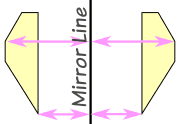
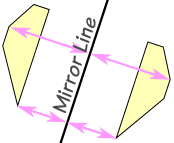
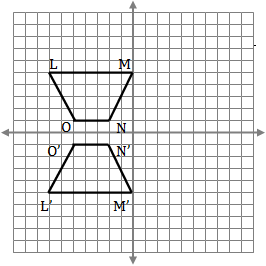
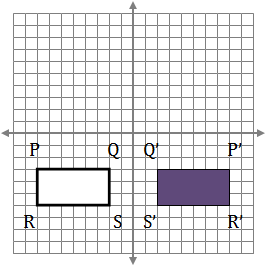


 2.)
2.)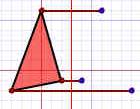 3.)
3.)








 , 2 is added to x , shifting the graph to the left 2 units. See Figure 5.6.
, 2 is added to x , shifting the graph to the left 2 units. See Figure 5.6.
 , 2 is added to y (which is
, 2 is added to y (which is 



 , the graph is horizontally compressed. See Figure 5.10.
, the graph is horizontally compressed. See Figure 5.10.
 , the graph is vertically stretched. See Figure 5.11.
, the graph is vertically stretched. See Figure 5.11.


 , the graph is vertically compressed. See Figure 5.13.
, the graph is vertically compressed. See Figure 5.13.












 y+ 2
y+ 2


